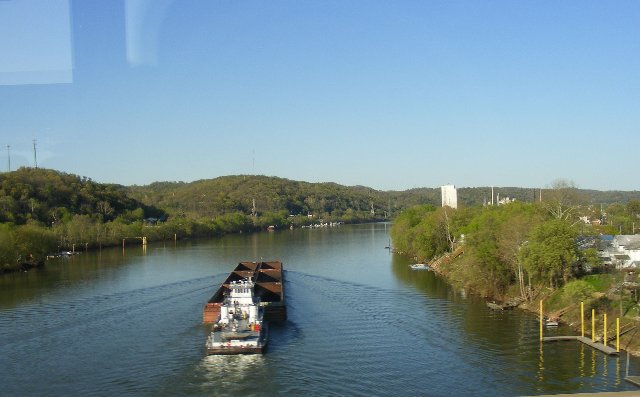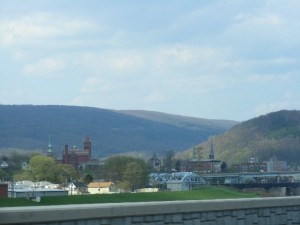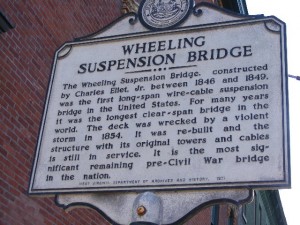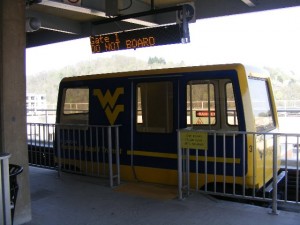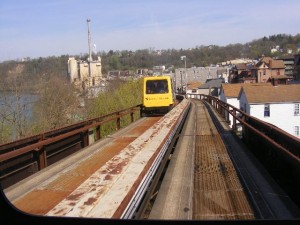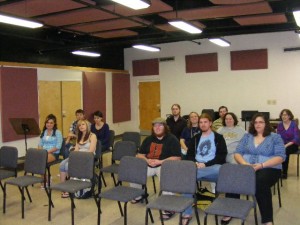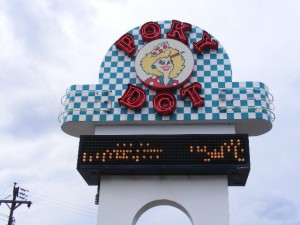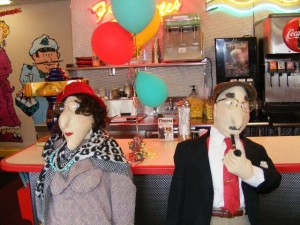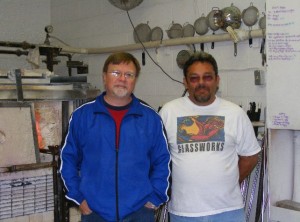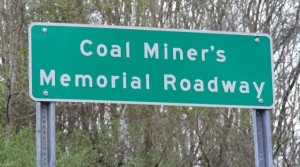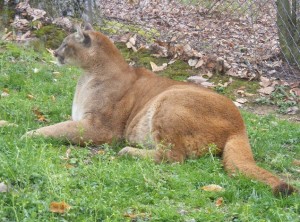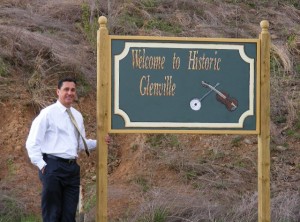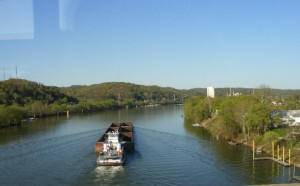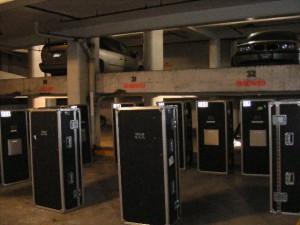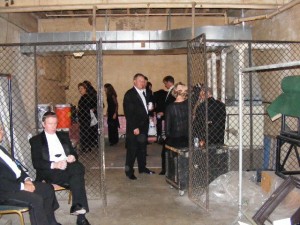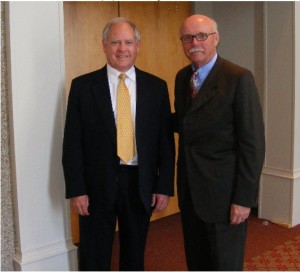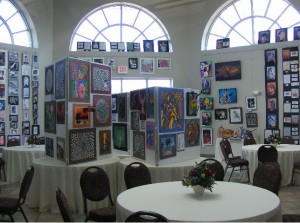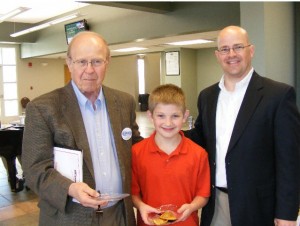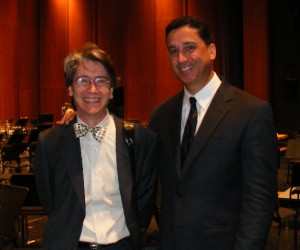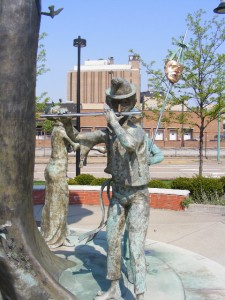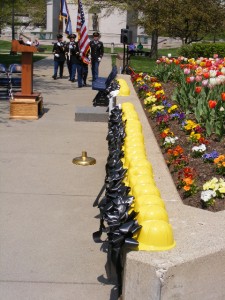National Symphony in West Virginia
Day 1
Monday, April 5, 2010
Down, up, down, up…..not a conductor’s baton, but the highways in Wild, Wonderful West Virginia. Today, April 5th, marks the start of the NSO’s eight-day American Residency in West Virginia. I took this photo in Cumberland MD on my way to Morgantown, WVA. No matter which route you choose to get here, you have to contend with mountain driving. The sweeping vistas are impressive, as are the “steep grade 9%” signs. I crossed the Eastern Continental Divide, and was mildly surprised to see a snowbank a few yards from the sign. Even the record-breaking amounts of snow we got 6 weeks ago are merely a memory now.
Today’s weather is certainly the warmest we’ve ever enjoyed at the beginning of a residency. I saw a thermometer along the highway that read 83 degrees, and I noticed that daffodils have nearly finished blooming. Even the magnolias look exhausted from this much heat so early in the season.
A high number of musicians elected to drive their own cars, so we are quite literally gathering here. There is a reception for us this evening, and even a few events. The brass quintet has a chamber music concert, as does the woodwind quintet, and one of our flute players, Aaron Goldman, is giving a master class. No sense in wasting a perfectly good evening off!
We’re using Morgantown as our base for the next few days, with events taking place in this city, as well as in the surrounding communities of Wheeling, Rowlesburg, Fairmont, Kingwood, Preston, Elkins, Mill Creek, Clarksburg, and Marlinton.
Update: Word is filtering through the orchestra about the mining disaster which happened this afternoon near Charleston, WVA.
Day 3
Wednesday, April 7th, Morgantown
Last night the NSO played in Wheeling, about 90 min’s from our hotel in Morgantown. The concert took place in the Century Theater, which was built 81 years ago, in the heyday of the city. The Wheeling Symphony performs in the same hall, but they are a smaller orchestra of about 65 players, and a stage extension had to be built to make enough space for all 100 of us. There isn’t much of a backstage area for this theater, though there were lots of dressing rooms downstairs.
The stagehands couldn’t wrangle our instrument trunks down the narrow staircases, so we found our trunks outside under a tent. Thank goodness it was a warm evening! (what if it had been raining, and in the 50’s, like typical spring weather?). Our residency concert program is Bernstein three dances from On the Town, Mozart’s Prague symphony, and Dvorak’s 8th.
I actually made two round trips to Wheeling yesterday, since I spoke at the Rotary Club luncheon, along with our executive director, Rita Shapiro, and principal percussionist Tony Ames, who grew up in Wheeling. In spite of the fact that I spent six hours in vehicles yesterday, I was glad to attend the luncheon, because it gave me an opportunity to find out more about Wheeling, and the people who helped the NSO make this Residency a reality.
A few facts: the Wheeling Symphony is mostly made of free-lance players from the Pittsburgh area. They play about 45 concerts a year.
Their conductor, Andre Raphael Smith, commutes from his home base in Philadelphia. Lou Karas, the state-wide coordinator for our residency, also makes her home in Pittsburgh. Lou is the one who told me that in all of WV there is no city larger than 50,000. (Charleston, the capitol, has a population of about 50,000, with 300,000 in its metropolitan area).
Sadly, the other news from yesterday, is that at least 25 miners are dead in the disaster near Charleston. My heart goes out to their families.
Day 3 continued
Wednesday night, April 7th, Morgantown, West Virginia University (WVU)
We just finished playing our second concert of this Residency, for one of the smallest audiences we’ve ever performed for. WVU has a new arts center, housing the theater we played in, the Theater and Art departments, and gallery space. It looked to me like the hall could have held 1200-1500 people, but this evening it held only a fraction of that number.
I knew something was wrong during the day when I mentioned our concert to local people, whether in a shop where I picked up a souvenir, or the restaurant where I had lunch. None of them seemed to know that the NSO was playing a concert this evening. I also noticed the absence of posters in store windows — not a good sign. Maybe we were competing with an athletic event? (At least this concert wasn’t the same night as the NCAA championship game). Too bad. We played a great concert this evening. The Prague symphony is challenging, beautiful, and refreshing, no matter the size of the audience.
Lou Karas, the state’s arts coordinator for this residency, told me yesterday that school districts have been backing out of their commitments with the NSO because there were so many “snow days” this winter, with the unusually heavy snows. Some schools missed 20-30 (!) days of school, and are scrambling now to get their hours fulfilled. Some of them contacted her to say they couldn’t take time to hear a group from the NSO; others wanted to know if we could “come another time.” That’s also too bad.
The violin group, Viva Violins, played at an assisted living center today. One of the violinists, Jane Stewart, said it was inspiring to meet a resident there who was 103! And she was especially touched when the listeners asked, “Can you please play one more piece?”
Lisa Emenheiser, our keyboard player, gave a two hour master class at the University this afternoon. All the performers were grad students, and she said they played at a very high level. One pianist brought in a violinist to play the Franck Sonata, others played pieces by Debussy and Scriabin, and astonishingly, someone even played the Rachmaninoff Third Piano Concerto.
One of the striking features about Morgantown is a mass transit system for the campus, known as the PRT: Personal Rapid Transit. Students use the system by swiping their student ID at the turnstile instead of paying an entry fee, and non-students pay a mere 50 cents per ride. As you enter, you press a button to tell the system which stop you want to go to, and a computer assigns a car to that route. Each car holds about 15 people. I waited 2-3 minutes for my first car to arrive (actually there were empty cars waiting when I got to the station, but I wasn’t assigned one of them). Once we got going, it was fun to ride in what seems more like an amusement park ride than mass transit.
However, the student riding in the car with me pointed out a few flaws in the system: if the power goes out, the car you’re in stops immediately (!), and the system runs limited hours, especially on weekends. I guess I was lucky that both of my rides were enjoyable.
Day 4
Thursday, April 8th, Morgantown, an orchestra day off
Today is technically a day off for the NSO, but there were 13 outreach events, ranging from my talk to music education students at Fairmont State University (20 miles away) to trombone and clarinet master classes at WVU here in Morgantown, to an artistic exchange in Mill Creek (a little over 60 miles away). A wind quintet is playing a chamber music concert in Marlinton, (nearly 100 miles away), a string quartet is playing tonight in Fairmont, and a flute-French horn-piano trio is playing in Clarksburg (approx 30 miles away). Including events I didn’t list here, the total mileage driven today comes to nearly 600 miles.
It’s not uncommon for residency events to turn out differently than we we think they will. My talk at noon in Fairmont was supposed to be for 30 music education majors. Instead I spoke to about a dozen students, only 3-4 of whom were in music ed, the rest were a varied lot, with little or no music in their backgrounds. I stressed the need to make connections between music and other classroom subjects, but it was hard for me to judge how they received my remarks. When we had a Q&A session at the end, some of the musically-inclined students asked me for practicing tips. One of the young men asked me how I keep focused when I’m practicing, and I think he was surprised when I told him that my biggest problem is finding enough time to practice, not how to fill up the hours that I’m supposed to be practicing.
All the information I read about Fairmont mentioned a little diner called Poky Dot, so I went there for lunch. It lived up to its reputation. No longer a teenager, I didn’t order one of their famous 8 oz burgers. Instead, I had a delicious bowl of soup, and a terrific apple dumpling (their desserts are as famous as their burgers). The diner has a working jukebox, stocked with hits from the ‘50s, and is famous for two characters who always sit at the counter, Marvin and Martha.
It began to rain hard as I left Fairmont to return to Morgantown, and the wind was gusting hard. No fun driving back to Morgantown, which meant sharing the road with 18 wheelers going 70 mph when I could barely see the road in front of me.
Day 5
Friday, April 9, Morgantown to Glenville
One of the reasons I decided to drive my own car on this Residency was to have the flexibility to see places the orchestra’s bus wouldn’t be going to. I didn’t drive directly fromMorgantownto our next hotel, inRoanoke; instead I exited the interstate at the Buckhannon exit. From there I drove east a few miles, through the town of Buckhannon, then took a smaller road a few miles, turned off on a dirt road, and wound around (following signs) to end up at one of the state’s many glass blowers, whose base of operations is on his grandfather’s farm. Ron Hinkle Glass is advertised heavily in tourist brochures, so I was expecting to find a factory, but it’s a small operation.
I arrived soon after visiting hours began, and the woman who greeted me said, “Would you like to watch the demonstration?” She directed me to one of the many buildings on the property (“please don’t pet the dogs”), where I found Ron Hinkle himself, and one of his workmen, who was making ‘kisses,’ shaped exactly like the famous candy. Ron spent several minutes chatting with me. Glass furnaces aren’t something you turn off every night and then re-start in the morning. He told me that his main furnace has not been shut off in 5 years, and that last month’s gas bill was over $4000. After he got back to work, I browsed in the gift shop. With such a wide selection of objects to choose from (ornaments, drinking glasses, vases, paperweights) it was tough to make choices, but I did my part to help him pay his bills.
As I drove back to the main road, I was glad to have the heat on in my car: there were snow flurries! The temperature was in the 30‘s, a big difference from just two days ago in Morgantown.More mountain driving. Randall Reid-Smith, the state’s Commissioner for Culture and History, quipped later in the day, “If you flattened out the state of West Virginia, it would be as big as Texas.” I don’t know if that’s true or not, but the scenery is amazing.
My next stop was the West Virginia Wildlife Center, where a conservation group has brought together animals formerly indigenous to the region, many of them hunted almost to extinction. It was nice to stretch my legs on the 1.25 mile hiking trail, but I didn’t have the right clothes to stay outside much longer than that. It was fascinating to observe the animals, whose enclosures are along the inside of the route. There were elk, bison, otters, foxes, coyotes, bobcats, eagles, hawks, owls, pheasants, even mountain lions.
Our concert Friday night was in the tiny town of Glenville(pop 1500), at Glenville State College (1500 students). There aren’t any large hotels in Glenville, but 50 miles away is a fabulous resort, in the heart of a large state park. Lucky us–our hotel was the resort! Stonewall Jackson Resort boasts an Arnold Palmer golf course, boating, fishing, cycling, cooking classes, hunting, sight-seeing cruises, hiking.. and a spa. The location is spectacularly gorgeous (the fall colors must be incredible).
Three of us were scheduled to give a pre-concert talk, so Associate conductor Emil de Cou, violinist Jane Stewart, and I set off in a van for Glenville, fifty miles from the hotel. Our navigator was Lou Karas, who read us a congratulatory email she got from Mill Creek, a remotely located village where NSO violinists Paula Akbar and Holly Hamilton played yesterday. When we arrived at the hall in Glenville, after many wrong turns down impossibly narrow “roads,” we wondered how on earth the NSO truck would navigate the route, but there it was, parked reassuringly out back.
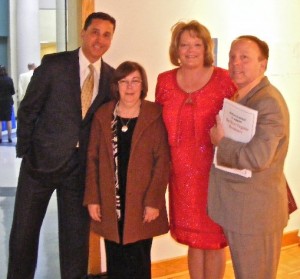
Emil de Cou, State Arts Coordinator Lou Karas, State Senator Karen Facemyer, Commissioner of Culture and History Randall Reid-Smith
Our talk turned out to be for an invitation-only cocktail party, and among the guests was State Senator Karen Facemyer (R-4th district). She told us the concert was sold-out, which made us very happy. Several people from the town said it was the first time a symphony orchestra had ever played there, and they had brought their children to see this major event. A man from the university said the school’s music program focuses on the area’s traditional music, which would explain the sign we saw welcoming us to the town: it shows a fiddle and a banjo.
During the opening minutes of the concert we heard a few small children settling down, but it was great to be playing for an audience which represented a large percentage of the population. I found myself wishing we had a program of several shorter pieces for this audience. An entire Mozart symphony followed by an entire Dvorak symphony might be asking a lot from an audience that’s not used to classical concerts. For an encore, Senator Facemyer conducted Stars and Stripes–she was great! Her sparkly red dress personified the mood of the music, and the crowd was clearly energized.
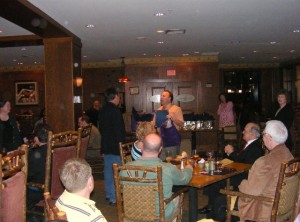
Randall Reid-Smith presenting NSO percussionist Ken Harbison (in dark jacket) with a letter from WV Governor Minchin
The evening wasn’t over. Our professional bus drivers navigated the twists and turns of the road (I was glad I wasn’t driving) to get us back to the hotel, where a lavish buffet was waiting for us. It was billed as “Appalachian style,” which seemed to mean several kinds of meat. Chicken, pork, roast beef, trout–all prepared with delicious sauces and accompaniments, salads, green beans with spicy ham, potatoes au gratin, and several kinds of dessert. Randall Reid-Smith presented hand-blown glass pieces to everyone on our staff, paperweights to everyone in the orchestra. He relayed greetings from Governor Minchin to two NSO musicians–Tony Ames, who grew up in Wheeling, and Ken Harbison, originally from Huntington. The governor might be able to attend our concert in Charlestonon Monday, but is currently preoccupied with the mining disaster. Randall, whose former career was as a professional singer, said he promised the governor that he’d sing a favorite song for us. Maestro Fischer urged him to do so, and we were treated to an entire medley of West Virginia-themed songs. What a lovely ending to a perfect day!
Day 6
Saturday, April 10, Huntington
We awoke to find thick frost on the grass around the Stonewall Jackson Resort. Mist swirled across the surface of the lake, as the air was colder than the water. Only the hardiest members of the NSO headed out for a morning run, the rest of us used the fitness center, or waited until the sun warmed things up a bit.
A string quartet headed out early to Huntington. They were scheduled to play an outdoor concert as the featured performers at a local festival. Violinists Holly Hamilton and Jane Stewart, violist Jim Deighan, and cellist Dave Teie, told me later that it was one of the “wildest” performances they’d ever given. They found themselves seated next to a road, with cars and trucks driving by as they played. No one had thought to provide them with wind clips, so pages of music flew off their stands. Microphones were in place so people at the festival could hear them, but Dave told me, “It made the kids sitting close to us shout at each other to be heard.” Jane said, “At least we had each other so we could laugh about it later.”
A good sense of humor is one of the things I prize most about my colleagues. No matter what conditions we find, this orchestra rises to the occasion and is able to find humor in it.
Having driven nearly 100 miles to get from Stonewall Jackson Resort to the downtown Marriott in Charleston, there was another hour of driving to get from Charleston to Huntington for our evening concert. The scenery in WV changes constantly. Crossing a bridge I saw an empty barge headed upriver. Around the next corner were huge smokestacks and cooling towers.
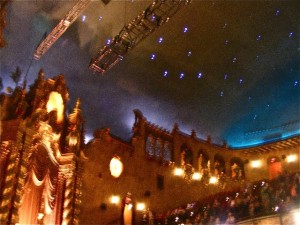
Interior (blurry) shot of the Keith Albee Theater, showing stars in the sky and massive Baroque columns
Huntington’s Keith-Albee Theater, an old vaudeville house, is a restored landmark from 1928. At one time it was the second largest theater in the country, after the Roxy in NYC, seating 2700 patrons. I’m sorry my photos don’t do justice to it. I wish you could have seen the interior of the theater: they don’t make ‘em like that anymore! Huge double spiraling Baroque columns on each side of the stage, a fake “sky” above with twinkling blue lights–I had to look twice to make sure we weren’t playing outdoors. It looked to me like the house was about 2/3 full, which means Huntington was our largest audience so far. Maestro Fischer was enjoying himself thoroughly, finding new places in Dvorak 8th to change dynamics and tempi.
When we arrived, our staff directed us to find our instrument trunks in the parking garage across the street from the theater. There was no backstage area, in fact there wasn’t even a backdrop, so the audience saw exposed pipes and wiring behind the NSO. Downstairs was a warren of narrow hallways and nearly-empty storage rooms. Some of them housed old furniture, others showed signs of construction. The hospitality area (coffee, water) was in an area that can be locked. Someone in the NSO dubbed it the “food cage.”
One of the women in the orchestra discovered with horror that the women’s restroom door was difficult to open, and once inside, it could only be opened again from the outside! After that we all shared the unisex facility closer to the “food cage.” The stairs that took us to stage level were dimly lit and very steep. Through it all my colleagues made jokes about “Phantom of the Opera” and took pictures of each other.
Today, Sunday, April 11th, we’re off to Princeton WV, the farthest south we can get in the state, deep in the heart of coal country.
Day 7
Sunday, April 11, Princeton, WV
For days now, West Virginia’s Commissioner for History and Culture, Randall Reid-Smith, has been saying, “Wait till you get to Princeton. The people there are so excited you’re coming!” He was right. Our 3pm matinee was sold out, which means 1000 people (out of the town’s population of 7000) were at our concert.
The hall where we played in Huntington was old enough to be on the National Register of Historic Places. The hall in Princeton, the Chuck Mathena Center, was new enough to smell new. It’s only been open for two years. It’s spacious, airy, and light. We found small presents waiting for us in the hospitality room. In each bag were brochures about places of interest in the area, a bottle of water, a few mints, and a magnet in the shape of the state, made out of coal.
Maestro Fischer began the program, as he has for all our other concerts, by saying, “The musicians of the National Symphony and I would like to honor the victims, and their families, of last Monday’s mining tragedy. You will hear an Air by Johann Sebastian Bach.” The other audiences we’ve played for met that announcement with silence, but in Princeton, deep in the heart of coal country, I heard someone say, “Amen,” and other people murmured their thanks. There was even a smattering of applause before we played.
There was a reception after the concert, but most of the orchestra wanted to get back to Charleston for the evening off. Those of us who stayed in Princeton were treated to one of the best experiences of the Residency. Not only was the food outstanding, but so were the people.
On my way out to the lobby, the first man I encountered was the man who built the hall, Charles Mathena. He built the hall in honor of his son, Chuck, who was tragically killed at the age of 18 in a drunk driving accident. Chuck was very involved in the arts, so his parents, who had long dreamed of creating an arts center for the community, turned their grief into a living memorial for him. Mr. Mathena kindly posed for a photo with fellow cellist, David Howard. Out in the lobby, Mr. Mathena showed us the art gallery, which currently features paintings and drawings by high school students. He told us that the arts had been cut from the school district’s budget years ago, and new school buildings are being designed without auditoriums. My jaw dropped–a high school with no auditorium? Where does the band give a concert? Where does the drama department stage their latest production? Mr. Mathena told us it was with great difficulty, and much arm-twisting, that the Center had recently signed a contract with the schools, allowing school performances to be held at the Center. The town of Princeton is very lucky to have such a dedicated citizen as Mr. Mathena, a quiet man with great vision.
Off to one side I noticed an armed guard. On the other side of the lobby were two more. I quickly learned the reason: state law specifies that events where alcohol is served must be attended by armed guards. My colleagues who attended a reception in Huntington said guards had also been present at that reception–which was in a private residence. It was sponsored by a local college, so it came under the state law. But that’s not all: at the bar (which also served soft drinks) there were two fliers posted. One carried fetal alcohol syndrome warnings, and the other was a chart showing how to calculate your blood alcohol content.
It was nearly 5:30pm, and I was hungry. Breakfast had been light, lunch nearly non-existent. Luckily, the food at the reception was outstanding. Baby asparagus wrapped in prosciutto, crab cakes, baby scallops wrapped in bacon, waldorf salad, spinach dip with crackers, pasta salad, ravioli, egg rolls, two kinds of stuffed mushrooms (both delicious)…and did I mention the chocolate fountain in the middle of the lobby? That’s where I met my new best friend, a boy in 5th grade named Atticus.
I’m in the “life is short, eat dessert first” club, so my first stop was the chocolate fountain, but Atticus had beaten me to it. He was dipping strawberries. I prefer pineapple, so we weren’t competing. I chose an especially large strawberry for him (he couldn’t reach it) and I was his new friend. We got to chatting about the joys of 5th grade, his favorite subjects (science and social studies), and his little sister, who was pestering him. Soon his father showed up, and congratulated me on the concert. He told me how grateful he was that the NSO performed in Princeton, and how much the kids in the community need exposure to the arts. I suddenly wished the NSO’s children’s concert (which we’re playing Monday morning for Charleston students) could be played in Princeton too.
After Atticus wandered off, his father told me that the boy had been reluctant to audition for a local group, but had ended up singing in the all-state choir last year! “Dad” also thanked me for the Bach Air. His wife, and her father and brother, own a small coal mine in the region, and know people who narrowly missed being in the mining tragedy. (One of my colleagues talked to a woman at the reception with a similar story. The concern in the community now is whether Massey will re-open the mine or whether they will close it down. Neither option is appealing.)
We were soon joined by Atticus’ grandfather, who was the architect for the Center. His wife is the dean of a local college, one of their sons is in the architectural firm, while Atticus’ father is an attorney. Atticus wanted my autograph, so I asked how he spelled his name. The grandmother told me, “Just like in To Kill a Mockingbird.”
As I put (another) cannoli on my plate, a woman commented, “I loved the Dvorak! Last year we heard it played by the Roanoke (VA) orchestra. Your version of it was much better–you made it sing!” A man standing nearby said, “I can’t believe how y’all play with such good rhythm!”
Next, I met the man responsible for the delicious food, as he’s the owner of two restaurants and a catering company, called Sugar Shack. He grew up in the area, served in the military, “cooking for generals,” and started up his company when he came home. Apparently his company is THE place in the region if you want good food.
Atticus was at my elbow again. “I think the lemon bars might be as good as the strawberries,” he told me, “but they are pretty messy to eat.” Then he saw a tray of chocolate-covered strawberries. “No way!” he blurted out. “I don’t even have to dip them!” I dared him to put chocolate from the fountain on a lemon bar, but he couldn’t figure out how to do that. I grabbed a plastic cup from the bar, held it under the fountain, and poured some over his lemon bar. I think he would have happily let me kidnap him at that point.
All too soon it was time to get back on the bus for the drive back to Charleston. I said goodbye to Mr. Mathena, to Atticus’ entire family, and several other people I’d had the good fortune to chat with. As I turned back to wave, Atticus ran across the room and gave me a big hug–I really didn’t want to leave.
Day 8
Monday, April 12, Charleston, our last day
Monday was the only children’s concert of our Residency, and unfortunately the hall was not packed. ‘Snow days’ that need to be made up don’t allow students to be excused from classes for field trips.
The Clay Center for Arts and Sciences in Charleston, the state’s capitol, is absolutely splendid, inside and out. Grant Cooper, the Music Director of the WV Symphony, based in Charleston, attended our morning concert and gave me a short history of the building. It was built in 2003, houses a large theater (1800 seats), a black box theater (200 seats), a planetarium, science exhibits, and a cafe and gift shop. Amazingly, all the money to build the center was raised locally. Students in Charleston have no idea how lucky they are to be able to attend a music performance in one theater, then go next door to check out the planetarium!
From the first notes of our children’s concert, all of us were in love with the hall. It has a warm sound, with lots of clarity, and when we’d finish a big chord, it would ring for a few seconds. What a nice surprise!
There are a couple interesting sculptures in front of the Clay Center. One of them has figures representing all the arts. I couldn’t help noticing that the flute player’s flute has no holes…
The afternoon was free time for me, so I explored the city. I found a wonderful bookstore; a shop just across the street that sold homemade ice cream; a market housing several gourmet food shops; and of course, the Capitol Building. I walked in for a look around–there wasn’t a security guard in sight! A huge chandelier hangs from the dome, and there are several interesting displays in the rotunda. Outside on the grounds, there are many beds of tulips, all in bloom.
In the middle of the afternoon, a memorial ceremony on the grounds of the Capitol was held to honor the 29 miners who died a week ago in Montcoal, WV. I saw a bevy of media trucks lined up on a side street, and then found the miner’s statue, where the service would take place. Honor guards were practicing their drills, and I saw 29 yellow miner’s helmets lined up on a marble ledge, each bearing a black ribbon. It brought tears to my eyes, but it didn’t seem proper for me, an outsider, to attend the ceremony, so I left before it began.
Governor Manchin could not attend our evening concert, but his wife, the First Lady, gave a welcoming speech, explaining our residency, and expressing her grief at the mining tragedy. After her remarks, our performance of the Bach Air seemed like the perfect touch. The audience remained silent when we finished.
The rest of the concert was a pleasure to play, as the hall contributed so much to our performance. Maestro Fischer is very responsive to each hall’s acoustic, and it was apparent after our first phrase of the Bach Air, that he was enjoying the hall immensely. He would listen to the reverberation in the hall, and adjust his timing of key phrases to take full advantage of the acoustics. He was beaming all evening.
As always, I have many happy memories of this trip, and a few regrets. I wish we could have played for more students, and I wish our evening concerts had been better attended. I hope we inspired many people who heard us, and that local arts programs will grow as a result of that inspiration. My biggest wish at the end of each Residency is that we could somehow keep in touch with the people we met during the week. I don’t want our visit to be one-time only, but part of an ongoing relationship.

